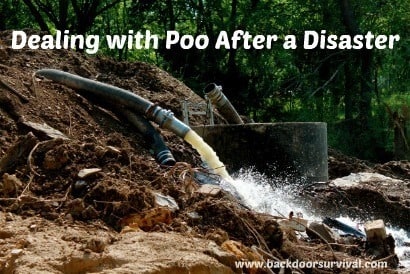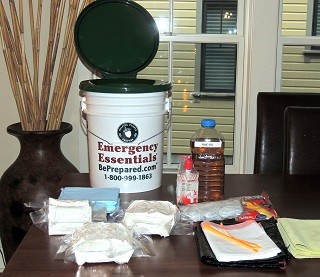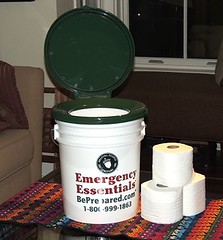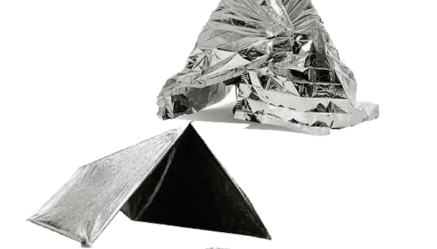This site contains affiliate links. As an Amazon Associate, I earn a commission from qualifying purchases at no extra cost to you. Full Disclosure Here.
Have you given any consideration of what you would do if your basic sanitation system was not available following a disaster? As unpleasant as this might seem, not having a viable sewer or septic system – or even an outhouse – could pose a problem if you have not given it some thought a head of time.
A few years ago I wrote and article that included a very basic Earthquake and Natural Disaster Emergency Checklist. In response, a reader wrote:
For item “Check for sewage and water lines damage”, you wrote if the sewage line is suspected to be damaged, one should avoid using the toilet.
What do you recommend people do instead? How does one deal with sewage when there’s no place to “go”? I know you do not want people using streams and creeks as their toilet. Cholera is the next reality when human waste is spread around so to speak. So an outhouse? A designated pit? A trench? What do people do when there’s an acre of pavement around their residence? Find a tree? That’s what they do when they walk their dogs.
A plan for this circumstance would be appreciated by those who will likely face this situation with everyone else in the city in a crunch. Not to mention those in the country who might find they are hosts to more people than their house can serve.
The answer, as with most things preparedness related, depends on a lot of factors.
Here on San Juan Island where I live, there are lots of wooded areas where we can build a latrine as well as boats in the nearby marina with well equipped sanitation systems including large holding tanks. Still, when the stuff hits the fan, where does one go to do their business especially in the city?
The following article taken from the Missouri Department of Health offers some viable suggestions:
SEWAGE DISPOSAL following an EARTHQUAKE or OTHER DISASTER
What will happen?
In an emergency such as a large magnitude earthquake, sewer lines will probably be damaged and become inoperable. Sewage may back up and broken water lines may become contaminated by sewage.What Should I Do?
If stoppage in sewer lines is suspected or obvious, discontinue discharge of wastewater in house or building sinks and drains and stop flushing toilets. Avoid contact with any overflow wastewater or sewage.If I Can’t Flush the Toilet, What Can I Use?
Large extra-strength trash bags (double bags) may be placed in tight plastic or metal containers, with tight fitting lids, or used as liners in toilets. Household disinfectant can be used for odor control. Final disposal can be by burying or by sanitary sewer when notified by public health officials.A dug latrine or trench 2 to 3 feet deep can be used to bury human waste. Spread a thin layer of powdered lime or dry chlorine bleach and a layer of earth each time it is used. Mark the latrine site with a stick so others know where it is.
Portable camp toilets, RV toilets, porta-potties, etc., can be used.
High occupancy complexes such as apartments, condominiums, and office buildings should consider making arrangements to obtain commercial chemical toilets.
What About Sewage Overflow in My House?
Wash all contaminated areas with detergent and water, then rinse with sanitizing solution of one tablespoon household bleach (5.25% sodium hypochlorite) to each gallon of water.Be sure to clean and sanitize all contaminated areas — pay special attention to cooking utensils, work surfaces and other surface areas such as floors and walls which your family and pets may come in contact with.
The Portable Potty Bucket
The recommendations above, while very basic, will give you some ideas to get started. But what have I done? I have put together a portable potty bucket that includes the following items:
Large, extra-strength trash bags plus an assortment of smaller bags
5-gallon bucket (which when the time comes, will be lined trash bags)
Toilet Seat
Toilet paper scrunched into a sealed FoodSaver bag (you could use homemade cloth squares instead)
Disposable gloves
Personal wipes
Hand sanitizer
Puppy/Potty pads for Tucker the Dog
Microfiber cloths
Disinfectant
Kitty Litter
Tie Wraps for closing off the used bags of waste
Holding tank chemicals similar to the type used in RVs and boats
Camp Shovel
Tarp
It was cost effective for me to order a bucket and portable bucket and toilet combo online but you could just as easily set up something similar yourself using a bucket and spare toilet seat that you have on hand. You could even skip the toilet seat and use a couple of well-spaced board laid across the top of the bucket.
As far as the other items, most are self-explanatory, except perhaps the disinfectant. I currently have packed away Pine-Sol only because I have a lot of it and no longer use it for household purposes. I am more comfortable using Pine-Sol than bleach but I am certain there are better alternatives that are more earth-friendly.
An option to the potty bucket is to line a regular toilet with large, heavy duty trash bags and do your duty in the relative comfort of your bathroom instead of using a bucket. Personally, though, I would rather lug a bucket outside for temporary storage of the bag of waste than to carry the bag outdoors without any support.
How to Use Your Disaster Potty
Every time the potty is used, some of the holding tank chemical or disinfectant should be sprinkled on top to keep the smell at bay. Kitty litter or garden lime will work well too. In a pinch, you can use some dirt.
Your waste paper (TP) should be placed in a separate bag that can be disposed of separately and perhaps even burned. If you are using cloth wipes in lieu of TP, they can also be placed in a separate bag for laundering later, when the water is turned back on and things, hopefully are back to normal.
When the bag of waste is about 2/3s to 3/4s full, top it off with more of your disinfectant. Tie the bag securely and take it outdoors until it can be disposed of properly (a subject for another time).
And most important, sanitize your hands afterward. This is not a step to be overlooked if you want to avoid sickness and disease. (See Survival Basics: Hand Sanitation For Good Hygiene.)
The Final Word
Something you absolutely must not do following a disaster is flush your toilet until you are 100% sure the sewer main is not down. If it is, flushing may likely cause a gross, smelly backup into your home. If you are on a septic system, you are in better shape but only if you have water available for flushing.
Regardless of whether you live in a city or the country, the need for a plan if and when your usual sanitary system is down is important. When you think about, this gives new meaning to the acronym, when the SHTF.
Enjoy your next adventure through common sense and thoughtful preparation!
Gaye
Click Here To Vote For Me at Top Prepper Websites!
If you have not done so already, please be sure to like Facebook which is updated every time there is an awesome new article, news byte, or link to a free survival, prepping or homesteading book on Amazon. You can also follow Backdoor Survival on Twitter, Pinterest, and Google+ and purchase my book, The Prepper’s Guide to Food Storage from Amazon.
Spotlight: I believe one of the better bargains out there is the Tote-able Toilet from Emergency Essentials. I have priced purchasing the bucket and toilet seat lid separately and found that it was more economical to pick up this kit. I have filled my portable potty with my sanitation supplies and even then there is room to spare.
Bargain Bin: Today I feature an assortment of products that can be used to put together what I like to call, a potty bucket.
Kirkland Signature Drawstring Trash Bags: I readily admit that I am a big believer in the Costco Kirkland brand. Since it is an all-day trip to go to Costco, sometimes I do the easy thing and order from Amazon.
Coghlan’s Folding Shovel: The purpose of a folding camp shovel is to give you the means to build a rudimentary latrine. Of course, having a camp shovel is handy for a number of other things, too. This one will fit nicely in your potty bucket.
Walex Porta-Pak Holding Tank Deodorizer: Anyone who has had a boat or RV knows that these holding tank deodorizers really do work.
Hand Sanitizer Gels: Alcohol based hand sanitizer gels kill 99% of bacterial on contact. They are inexpensive and easy to use.
FoodSaver: As far as I am concerned, a FoodSaver is not a splurge. I use mine daily.
No Rinse Cleansing & Deodorizing Bathing Wipes: One wipe is more than enough for a complete “bath”. These are a good backup when traditional showers are not available such as the week or weeks following a disaster.
PURELL Sanitizing Hand Wipes Individually Wrapped 100-ct. Box: I prefer individually wrapped sanitizing wipes because they are easy to carry in a pocket, back or travel kit. As long as they meet the 60% or more alcohol criteria, the brand should not be important.
Amazon Basics Microfiber Cleaning Cloths These magic rags are the rags that keep giving. Seriously. I have had mine for over 10 years. They may be a bit stained but they still work. Forget about paper towels. For a one time cost you are all set. I plan to cut up some of my older stained cloths to use as washable TP – just in case.
~~~~~~~~~~














48 Responses to “Dealing with Poo After a Disaster”
this information is priceless. really valuable. keep up the good work! jim
One thing that can be useful for folks living in apartments or inner city houses without garage/much land: instead of buying coffee in paper bags, buy it in those big resealable tins – the same size as the #10 cans you buy prepper food in. Apart from anything else, it will be cheaper and will keep fresh longer, and it doesn’t really taste that different. Keep all your tins and lids once you have drunk the coffee! They are useful for all sorts of things, including collecting and disposing of human waste in small manageable batches when you don’t have the space resources of a suburban or rural house.
Any one out there have any info on the propane-fired toilets?
a couple of issues is would like to address.
1 – the first and main, is the toilet situation, if you have a disabled person in home, you should have a potty seat. if someone is bringing someone who is disabled, make sure they bring the potty seat. i am disabled and take it with me wherever i go to stay away from home. why? i have a paralysis form the waist down. while i am mobile, without a stable seat, i could get hurt if i fall over trying to go potty on an unstable bucket. help is not always available for me to rely on.
2 – sanitary pads, there is always a sale and cheap ones are sold for as little as $3 a bag. The Dollar Store has them for only $1/bag, stock up! You can also make them like they did once upon a time before disposable napkins, they called the “Granny Pads”. you take strips of felt and other soft material, and sew them into a napkin. large ones for heavy times, small for lighter. you can also line the bottom with a washable, water/fluid resistant material. Dollar general sells dish towels everyday for $1, and Dollar general has a sale every holiday, making their leftovers at .50 each towel. stock up and make your own.
3 – Bladder control, Dollar general has a nice sale on bladder control items. quite often they have them on the clearance shelf, which today while grocery shopping i bought 10 bags of them at $1 each! these can also double for sanitary pads, or in an emergency as sterile covering for wounds, and can fit nicely under a bed or in the top/bottom of a closet!
4 – once or twice a year, make a trip to your fabric store! they get great deals on fat quarters, bundles, and whole rolls of fabric. this can be used for almost anything, including tarps, bedding, makeshift diapers, emergency sterile dressings, makeshift pads, replacement for rope in strips, you can do a lot with it.
Hope this Helps!
Good advice – Everyone always considers Water, Food, Fire, Guns/Ammo, etc. for their prepper supplies, but proper sanitation is one of those things that make us civilized. Not to mention – sanitary!
Some disasters could see a rise in diseases like Cholera, so dealing with “poo” is very important 🙂
I agree with you William, but it brings to mind Erma Bombec saying the grass is always greener over the septic tank. Just thinking.
Hello everyone. Regarding using urine for your garden or pouring it directly on your property, please research urine disposal first. Urine has lots of salts including phosphrus which if used properly can benefit your garden or can burn the roots of plants quickly. Urine can be used in your garden if diluted four to one..one quart of urine to 4 quarts of water. Human excretement is another game all together…in the books I’ve read experts have either said don’t use it for one year in your garden or if composting, it must be composed for at least one year. Please, before you set up a compost bin read up on it. It sounds so simple but there are lots of do’s and don’ts. Temperature especially, if your internal temperature gets above 149 degrees then you loose the good bacteria and if it’s under 130 degrees it doesn’t kill the bad stuff….So please read upon it before the SHTF…Good luck Rusty
P.S. People making home made candle wicks used to urinate on the cotton wicks to stablize the flame so it wouldn’t flicker so much and opens up the cotton fibers to better absorption of the oil for fuel. Phosphrus also gives off a pretty blue flame in the wick to sit and watch.
I did not realize you are on San Juan Island! I am on Key Peninsula. We are Christian preparers and live on the best spot in the world, IMHO. Just two days ago 2.5 acres came up for sale behind us for just $29k. Land is unimproved, close to Sound, quiet, partially cleared, in area of like minded people. I am looking for a quiet neighbor.
I don’t have an answer for those living in an apt. That will be a special challenge for sure. My guess would be if there is some land around the building, designating one area for ‘collection point’. Reserving the rest of the space away from there for growing food.
Some points as I read this:
* If one has a yard, you can do a DIY doggie septic tank. It involves taking a large trash can, cutting out the bottom and burying it up to the handles, then using that as a repository for waste. It works for dogs. I used to have a neighbor who took a 5 gallon buck and did this for his 2 little dogs. With an occasion sprinkling of lime, it decomposed with time and that part of his yard was always green and well fertilized.
* The cheapest way would be the 5 gallon with toilet lid. Works great when there isn’t another choice. It also can work as a spare when illness is rampaging through the house. If putting it in one place, next time you’re at a 2nd hand store, buy that old walker and repurpose it by designating that to go around your bucket toilet for those who might need to grab something to sit down or get up. Also, for stability, do the sandbag principle. Except where you place your feet, place sandbags so the bucket can’t tip over. It works for keeping water out of places it shouldn’t be, it can work this way too. Or stake the walker down as you would a tent.
* Working up from the basic bucket toilet, a portable toilet works great too. Along with the DIY doggie septic tank or another repository, they were designed with this in mind. If you have someone who has trouble lowering themselves. Keep two concrete blocks as part of your stores so the bucket or toilet can be raised up. We’ve done this when camping with seniors and other disabled people.
* Composting toilets—while spendy, it’s my preferred way to go, especially if you have solar power or a generator.
** When considering using cloth wipes, consider how the used ones will be stored until you wash them. Remember they will be petri dishes for disease as well as attracting vermin. I have a goal of getting a galvanized trash can for these and a method for keeping critters out of them. I’ve just bought one large cauldron to wash them. I will use cold water to wash them. Then as I saw my mother and grandmother do, when I was a child and we lived in primitive conditions, I want to get another which can be placed on an open fire. The second one will be allowed to come to boiling point and (if cast iron can be taken off, if stainless steel kept on the fire to keep it boiling) so as to sterilize the clothes, then of course, either hanging or laying out on bushes for the sun to finish the sterilization process.
****Someone mentioned tampons. I keep some in my first aid kit (along with panti liners and pads) for emergency needs. For that time of the month—–there are re-useable cups which can be used. Many young women like them even better than the disposables because they are reusable, and less waste to deal with.
Gaye, thanks for the article. I hadn’t thought about large pipes breaking and/or the backup issue.
seems nobody has thought of composting poo, it can be composted in the normal way just leave it longer to bio degrade, it can then be used as a mulch on paths and around trees.
I agree that composting poo is very important. I don’t like the idea of the plastic bags. I tend to think when the SHTF we need a permanent solution. I plan to build a series of composting bins NOW. Then use the bucket/seat combo as a toilet, layering with sawdust, lime, or dead leaves or dirt. Whatever I can find or prep in large quantities. As needed the bucket will be dumped in the first compost bin and composting will be carried out as per usual. I also agree that pee and poop should be separated. Toilet paper can be composted with the poop and sawdust, or cloths can be used and then washed. I think it depends how long the disaster lasts and how difficult is it to obtain water for non-drinking purposes. Another thing I want to do NOW is establish water collection. I think a trash can with a screen secured over it, or a kid’s swimming pool would be cheaper than the roof/gutter systems and since I’m going to boil it anyway, why pay more. Which brings me to wood collection. I would like to get a volcano stove NOW so that I can cook and boil water without using a lot of wood. Which brings us right back to washing poo and pee cloths for sanitizing them, washing hands after composting, etc. I just feel very strongly about having permanent options in place that would last indefinitely if TSHTF.